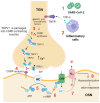Receptors Involved in COVID-19-Related Anosmia: An Update on the Pathophysiology and the Mechanistic Aspects
- PMID: 39126095
- PMCID: PMC11313362
- DOI: 10.3390/ijms25158527
Receptors Involved in COVID-19-Related Anosmia: An Update on the Pathophysiology and the Mechanistic Aspects
Abstract
Olfactory perception is an important physiological function for human well-being and health. Loss of olfaction, or anosmia, caused by viral infections such as severe acute respiratory syndrome coronavirus 2 (SARS-CoV-2), has received considerable attention, especially in persistent cases that take a long time to recover. This review discusses the integration of different components of the olfactory epithelium to serve as a structural and functional unit and explores how they are affected during viral infections, leading to the development of olfactory dysfunction. The review mainly focused on the role of receptors mediating the disruption of olfactory signal transduction pathways such as angiotensin converting enzyme 2 (ACE2), transmembrane protease serine type 2 (TMPRSS2), neuropilin 1 (NRP1), basigin (CD147), olfactory, transient receptor potential vanilloid 1 (TRPV1), purinergic, and interferon gamma receptors. Furthermore, the compromised function of the epithelial sodium channel (ENaC) induced by SARS-CoV-2 infection and its contribution to olfactory dysfunction are also discussed. Collectively, this review provides fundamental information about the many types of receptors that may modulate olfaction and participate in olfactory dysfunction. It will help to understand the underlying pathophysiology of virus-induced anosmia, which may help in finding and designing effective therapies targeting molecules involved in viral invasion and olfaction. To the best of our knowledge, this is the only review that covered all the receptors potentially involved in, or mediating, the disruption of olfactory signal transduction pathways during COVID-19 infection. This wide and complex spectrum of receptors that mediates the pathophysiology of olfactory dysfunction reflects the many ways in which anosmia can be therapeutically managed.
Keywords: ACE2 receptor; COVID-19; TRPV1; anosmia; basigin; neuropilin 1; sustentacular cells.
Conflict of interest statement
The authors declare that they have no conflicts of interest to disclose.
Figures



Similar articles
-
COVID-19 Anosmia: High Prevalence, Plural Neuropathogenic Mechanisms, and Scarce Neurotropism of SARS-CoV-2?Viruses. 2021 Nov 4;13(11):2225. doi: 10.3390/v13112225. Viruses. 2021. PMID: 34835030 Free PMC article. Review.
-
More that ACE2? NRP1 may play a central role in the underlying pathophysiological mechanism of olfactory dysfunction in COVID-19 and its association with enhanced survival.Med Hypotheses. 2021 Jan;146:110406. doi: 10.1016/j.mehy.2020.110406. Epub 2020 Nov 20. Med Hypotheses. 2021. PMID: 33246692 Free PMC article.
-
Expression of the SARS-CoV-2 Entry Proteins, ACE2 and TMPRSS2, in Cells of the Olfactory Epithelium: Identification of Cell Types and Trends with Age.ACS Chem Neurosci. 2020 Jun 3;11(11):1555-1562. doi: 10.1021/acschemneuro.0c00210. Epub 2020 May 19. ACS Chem Neurosci. 2020. PMID: 32379417 Free PMC article.
-
Non-neuronal expression of SARS-CoV-2 entry genes in the olfactory system suggests mechanisms underlying COVID-19-associated anosmia.Sci Adv. 2020 Jul 31;6(31):eabc5801. doi: 10.1126/sciadv.abc5801. Epub 2020 Jul 24. Sci Adv. 2020. PMID: 32937591 Free PMC article.
-
The roles of Eph receptors, neuropilin-1, P2X7, and CD147 in COVID-19-associated neurodegenerative diseases: inflammasome and JaK inhibitors as potential promising therapies.Cell Mol Biol Lett. 2022 Feb 2;27(1):10. doi: 10.1186/s11658-022-00311-1. Cell Mol Biol Lett. 2022. PMID: 35109786 Free PMC article. Review.
Cited by
-
Development of an rpS6-Based Ex Vivo Assay for the Analysis of Neuronal Activity in Mouse and Human Olfactory Systems.Int J Mol Sci. 2024 Dec 7;25(23):13173. doi: 10.3390/ijms252313173. Int J Mol Sci. 2024. PMID: 39684883 Free PMC article.
-
Polyunsaturated Fatty Acids as Potential Treatments for COVID-19-Induced Anosmia.Biomedicines. 2024 Sep 12;12(9):2085. doi: 10.3390/biomedicines12092085. Biomedicines. 2024. PMID: 39335598 Free PMC article. Review.
-
Ion Channels in Odor Information Processing of Neural Circuits of the Vertebrate Olfactory Bulb.Int J Mol Sci. 2024 Dec 10;25(24):13259. doi: 10.3390/ijms252413259. Int J Mol Sci. 2024. PMID: 39769024 Free PMC article. Review.
-
Persistent Post-COVID-19 Olfactory Dysfunction and Its Association with Autonomic Nervous System Function: A Case-Control Study.Diseases. 2024 Dec 28;13(1):4. doi: 10.3390/diseases13010004. Diseases. 2024. PMID: 39851468 Free PMC article.
References
Publication types
MeSH terms
Substances
LinkOut - more resources
Full Text Sources
Medical
Miscellaneous

